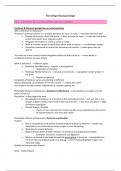Samenvatting
Hoorcollege samenvatting van Neuropsychology
- Instelling
- Radboud Universiteit Nijmegen (RU)
Hoorcollege samenvatting van Neuropsychology van de Radboud Universiteit. De samenvatting is vooral in het Engels, omdat de colleges in het Engels werden gegeven, er staat tussen door wat aantekeningen in het Nederlands om het te verduidelijken.
[Meer zien]




